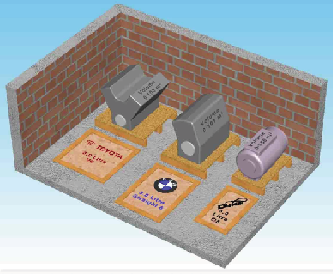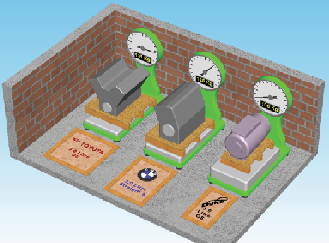DUKE ENGINES’ WEIGHT, SIZE & SHAPE BENEFITS
The physical size, weight and shape of an engine package imposes large constraints on the Design Engineer and heavily impacts performance, production, production cost, storage and shipping of the engine. The Duke Engine's unique design delivers an engine package that produces unmatched gains across all these factors, allowing unique design freedoms combined with an ease of production, shipping and storage.
Package and design prospects*
Package potential. The Duke engine is essentially cylindrical in shape, with the output shaft on the axis of the cylinder and exiting one or both ends. Importantly all of the fluid porting and electrical connections can be on one end face.
The outer Diameter of the Duke engine casing is driven by the Bore of the cylinders that it contains. An optimised Duke engine of automotive size range can be designed with an external diameter of approx 3.4 times the bore.
An over square (bore to stroke of ratio 1.2) 3.0L Duke engine would have an optimized external case diameter of approx 330 mm, with a 5.2L Duke fitting inside a 400mm diameter.
The current prototype V3 (5cyl 3L) long engine dimensions are 641mm L x 370mm W x 375mm H and so fits in a nominal cuboid "packing crate" of 89L, and has a nominal external diameter of 373mm. The current height and width have the scope to be reduced further.
A 1.0L (~100 HP) engine would be about 230mm (9") optimized diameter, allowing it to fit inside a standard sized"carry on" airline bag.
DIMENSION COMPARISON WITH BMW M54B30
|
|
|
|
Duke Series V3 |
BMW |
Duke % |
|
|
M54B30 |
Improvement |
|
|
|
|
|
|
Dimensions LxWxH mm |
641x370x375 |
770x550x650 |
|
|
|
|
|
Box Vvolume Litres |
|
89 |
|
275 |
68% |
|
|
‘Shrink wrap’ Volume volume Litres |
65 |
|
101 |
36% |
|
|
|
Weight (dry) kg |
|
|
106 |
|
124.5 |
15% |
|
Torque max Nm |
|
328 |
|
300 |
9% |
|
|
Torque per litre Nm/L |
|
109 |
|
101 |
8% |
|
|
Engine Static static Capacity capacity Litres |
|
2.995 |
|
2.979 |
|
|
|
Engine Dynamic dynamic Capacity capacity Litres |
3.594 |
|
2.979 |
|
|
|
|
Compression ratio Litres |
|
12.5:1 |
|
10.2:1 |
|
|
The M54B30 is a 3.0 L in-line 6 cylinder engine. Bore 84 mm, stroke 89.6 mm. It is an all-alloy engine with Al-Sil block. Uses SFI fuel injection, 4 valves per cylinder with Double VANOS (variable valve timing). The M54B30 was on the Ward's 10 Best Engines list through 2001-2003.
ENGINE LENGTH
The length of the engine "long block" (engine without ancillaries and manifolds)is a more complex function depending on Stroke and other system and drive features, so isn't quite as simple to quantify as diameter. The current 3.0 Litre V3 Duke prototypes long block is 641mm long.
Duke Range extender 1.25Ltr concept long block is 466mm long. Both of these Duke examples are not fully optimised for length, but compare favourably with conventional engines, even when in V configuration.
Weight size and shape continued –
Comparisons have been done between the current V3 3.0L Duke engine and comparable automotive engines. The external volume and mass of the Duke V3 has been compared to some conventional automotive engines, including the BMW 3.0L M54B30, Nissan 3.5L VQ35DE and Toyota 3.0L 1MZ-FE (see comparison sheets previous and below)
The "Crate volume" of these comparative engines being measured as between 275L and 326 L making the Duke engine "Crate" at 89L, up to 70% smaller. The BMW and Toyota competitor engines and Duke engine were also "shrink wrapped" in plastic and immersed in water to closer estimate actual engine volume and make fairer comparisons between the different shapes.
DIMENSION COMPARISON WITH TOYOTA 1MZ-FE
|
Duke Series V3 |
Toyota 1MZ-FE |
Duke % |
|
|
|
|
|
|
|
Improvement |
|
|
|
|
|
|
|
|
|
Dimensions LxWxH mm |
|
641x370x375 |
680x690x695 |
|
|
|
|
|
|
Box Volume volume Litres |
|
|
|
89 |
|
326 |
|
73% |
|
‘Shrink wrap’ volume Litres |
|
65 |
|
100 |
|
35% |
|
|
|
Weight (dry) kg |
|
|
|
106 |
|
131 |
|
19% |
|
Torque max Nm |
|
|
328 |
|
285 |
|
15% |
|
|
Torque per litre Nm/L |
|
|
109 |
|
95 |
|
15% |
|
|
Minimum fuel consumption g/kWh |
245 |
|
237 |
|
-3% |
|
|
|
|
Number of parts |
|
|
1039 |
|
1063 |
|
2% |
|
|
Engine Static static Capacity capacity Litres |
|
|
2.995 |
|
2.995 |
|
|
|
|
Engine Dynamic dynamic Capacity capacity Litres |
|
3.594 |
|
2.995 |
|
|
|
|
|
Compression ratio |
|
|
12.5:1 |
|
10.5:1 |
|
|
|
The Toyota MZ engine family is a V6 piston engine series with an aluminium engine block and aluminium alloy DOHC cylinder heads. It uses Multi-fuel injection, has 4 valves per cylinder and features a one-piece cast camshaft and cast aluminium intake manifold. The 1MZ-FE was on Ward's 10 Best Engines list for 1996.
DIMENSION COMPARISON WITH NISSAN VQ35DE
|
Duke Series V3 |
|
Nissan VQ35DE |
|
Duke % |
|
|
|
|
|
|
Improvement |
|
|
|
|
|
|
|
|
|
|
Dimensions LxWxH mm |
|
|
641x370x375 |
|
690x630x675 |
|
|
|
|
|
Box Volume volume Litres |
|
|
89 |
|
|
293 |
|
70% |
|
|
Minimum Fuel fuel Consumption consumption g/kWh |
245 |
|
|
240 |
|
|
-2% |
|
|
|
Fuel Consumptionconsumption |
|
|
|
|
|
|
|
|
|
|
(2000rpm 200kPa BMEP) g/kWh |
365 |
|
|
365 |
|
|
0% |
|
|
|
Torque max Nm |
|
|
328 |
|
|
363 |
|
-10% |
|
|
Torque per litre Nm/L |
|
|
109 |
|
|
103 |
|
6% |
|
|
Weight (dry) kg |
|
|
|
106 |
|
|
>120 |
|
>12% |
The Nissan VQ35 engine is widely considered to be the world's benchmark V6 engine for its combination of smoothness, reliability and high power output.
The 3.5 L (3498 cc) VQ35DE is used in many modern Nissan vehicles. It has a bore of 95.5 mm and stroke of 81.4 mm. It features an Aluminium cylinder block and heads, forged steel connecting rods, a micro-finished one-piece cast camshaft. It has low-friction molybdenum coated pistons and a high-flow tuned induction system.. Power output ranges from 170 kW to 222 kW and torque from 334 Nm to 363 Nm.. It was on the Ward's 10 Best Engines list from 2002 through to 2007.
A shrink wrapped V3 duke engine volume of 65L compared to 100L for the Toyota and 101L for the BMW. The amount of package advantage that is realised will be very application specific, and depends upon the package shape available and how well is suited to both Duke and conventional engines. It will be very clear from the comparisons drawn, that the Duke engine offers a very significant size advantage compared to conventional automotive engines.


SHIPPING SIZES
The diagrams to the left and below give a practical indication of the size, volume and shipping weight benefits of the current Duke engine 'crate' package compared to the Toyota and BMW.
